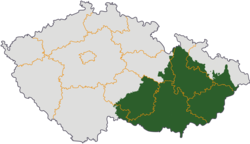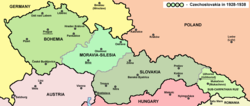Moravia

Moravia (Czech and Slovak: Morava; Template:Audio-de; Hungarian: Morvaország; Polish: Morawy) is a historical region in the east of the Czech Republic. It takes its name from the Morava River which rises in the northwest of the region.
Geography


Moravia occupies most of the eastern third of the Czech Republic including the South Moravian Region and the Zlín Region, as well as parts of the Moravian-Silesian, Olomouc, Pardubice, Vysocina and South Bohemian regions.
In the north, Moravia borders Poland and Czech Silesia; in the east, Slovakia; in the south, Lower Austria; and in the west, Bohemia. Its northern boundary is formed by the Sudetes mountains which become the Carpathians in the east. The meandering Thaya flows through the border country with Austria and there is a protected area on both sides of the border in the area around Hardegg.
At the heart of the country lie the sedimentary basins of the Morava and the Thaya at a height of 180 to 250 m. In the west, the Bohemian-Moravian Heights rise to over 800 m although the highest mountain is in the north-west, the Praděd (German: Altvater) in the Sudetes at 1490 m. Further south lie the Jeseníky highlands (400 to 600 m) which fall to 310 m at the upper reaches of the River Oder (the Moravian Gate) near Hranice na Moravě and then rise again as the Beskids to the 1322 m high Lysá hora (German: Kahlberg). These three mountain ranges plus the "gate" between the latter two form part of the European Watershed. Moravia's eastern boundary is formed by the White Carpathians which reach a maximum of 970 m at Velká Javořina.
During the past few centuries, Moravia (also thus known as Moravia-Silesia) has also included a small portion of the former province of Silesia - the so-called Moravian Silesia (When Frederick the Great annexed most of ancient Silesia (the land of upper and middle Oder/Odra river) to Prussia, Silesia's southernmost part remained with the Habsburgs).
Economy
In the south around Hodonín and Břeclav the land is part of the Viennese Basin and petroleum and lignite are drilled for in its deeper sediments. In the area around Ostrava there was intensive coal mining until around 1995. Iron, chemicals, leather and building materials are the main industrial goods. The main economic centres are Brno, Olomouc and Ostrava. As well as other agriculture, Moravia is noted for its viticulture; it contains 94% of the Czech Republic's vineyards and is at the centre of the country's wine industry.
History

Around 60 BC the Celtic Boii people withdrew from the region and were succeeded in turn by the Germanic Quadi and in the 6th century the Slavic tribes. At the end of the 8th century the Moravian Principality came into being in present-day south-eastern Moravia, Záhorie in south-western Slovakia and parts of Lower Austria. In 833 this became the state of Great Moravia with the conquest of the Principality of Nitra (present-day Slovakia and parts of northern Hungary). Their first king was Mojmir I (ruled 830-846). Great Moravia reached its greatest territorial extent in the 890s under Svatopluk I. At this time, the empire encompassed the territory of the present-day Czech Republic and Slovakia, the western part of present Hungary (Pannonia), as well as Lusatia in present-day Germany and Silesia and the upper Vistula basin in southern Poland. After Svatopluk's death in 895, the Bohemian princes defected to become vassals of the East Frankish ruler Arnulf of Carinthia, and the Moravian state ceased to exist after being overrun by invading Magyars in 906-7.
Following the defeat of the Magyars by Emperor Otto I at the Battle of Lechfeld in 955, Otto's ally Boleslaus I, the Premyslid ruler of Bohemia, received Moravia. Boleslaus I of Poland annexed Moravia in 999, and ruled it until 1019, when the Premyslid prince Bretislaus recaptured it. Upon his father's death in 1035, Bretislaus also became the ruler of Bohemia. In 1054, Bretislaus decreed that the Bohemian and Moravians lands would be inherited together by primogeniture, although he also provided that his younger sons should govern parts of Moravia as vassals to his oldest son.
Throughout the Premyslid era, junior princes often ruled all or part of Moravia from Olomouc, Brno, or Znojmo, with varying degrees of autonomy from the ruler of Bohemia. Moravia reached its height of autonomy in 1182, when Emperor Frederick I elevated Moravia to the status of a margraviate (or mark), immediately subject to the emperor, independent of Bohemia. This status was short-lived: in 1197 Vladislaus III of Bohemia resolved the succession disupte between him and his brother Ottokar by abdicating from the Bohemian throne and accepting the margraviate of Moravia as a vassal of Bohemia.
Since then, Moravia has shared its history with Bohemia. The Premyslid dynasty became extinct in 1306, and in 1310, John of Luxemburg became king of Bohemia. Moravia and Bohemia remained within the Luxemburg dynasty of German kings and emperors, until inherited by Alfred II of Habsburg in 1437.
In the course of the Hussite wars, the Habsburgs lost control of Bohemia and Moravia, and the Czech lands were temporarily divided. The Hussite George of Podebrady was elected king of Bohemia in 1458. In 1466, Pope Paul II excommunicated George and forbade all Catholics from continuing to serve him, and in 1469, Matthias Corvinus, king of Hungary, conquered Moravia. Moravia was reunited with Bohemia in 1490 when Vladislaus Jagellion, who had succeeded George as king of Bohemia in 1471, then also succeeded Matthias as king of Hungary. In 1526, Vladislaus' son Louis died in battle, and the Habsburg Ferdiand I was elected king of Bohemia. Moravia remained with Bohemia as a Habsburg possession until the end of World War I.
Until 1641 Moravia's capital was the centrally-located Olomouc, but after its capture by the Swedes it moved to the larger city of Brno which resisted the invaders successfully. The Margaviate of Moravia had its own "zemský sněm" or Landtag (diet) whose deputies were elected (in the years following 1905) in ethnically separate German and Czech constituencies.
Following the break-up of the Austro-Hungarian Empire in 1918, Moravia became part of Czechoslovakia (and was part of the Protectorate of Bohemia and Moravia during the German occupation of Czechoslovakia in World War II). In 1945 the ethnic German minority of Moravia were expelled. (See Expulsion of Germans after World War II). With the break up of Czechoslovakia, Moravia became a part of the Czech Republic in 1993.
People
The Moravians today are a Slavic ethnic group who speak various dialects of Czech. Some Moravians regard themselves as an ethnically distinct group; others consider themselves to be ethnically Czech. In the census of 1991 1,362,000 (13.2%) of the Czech population described themselves as being of Moravian nationality. In the census of 2001 this number had decreased to 380,000 (3.7% of the population).
Sigmund Freud was born in a Moravian town called Freiberg by German speakers, called Příbor in Czech, Czech Republic) on May 6, 1856.
Other
Moravia is also known for producing the World's thinnest biscuit, Moravian Spice Cookies.
There is a little competitiveness between Moravians and Bohemians, but very mild and more in the way of being a source of humour than animosity.
Sources
- Róna-Tas, András (1999) Hungarians & Europe in the Early Middle Ages: An Introduction to Early Hungarian History translated by Nicholas Bodoczky, Central European University Press, Budapest, ISBN 963-9116-48-3 ;
- Kirschbaum, Stanislav J. (1996) A History of Slovakia: The Struggle for Survival St. Martin's Press, New York, ISBN 0-312-16125-5 ;
- Much of the content of this article comes from the equivalent German-language Wikipedia article as of August 29 2005.
- Constantine Porphyrogenitus De Administrando Imperio edited by Gy. Moravcsik, translated by R.J.H. Jenkins, Dumbarton Oaks Edition, Washington D.C. (1993) p. 181



